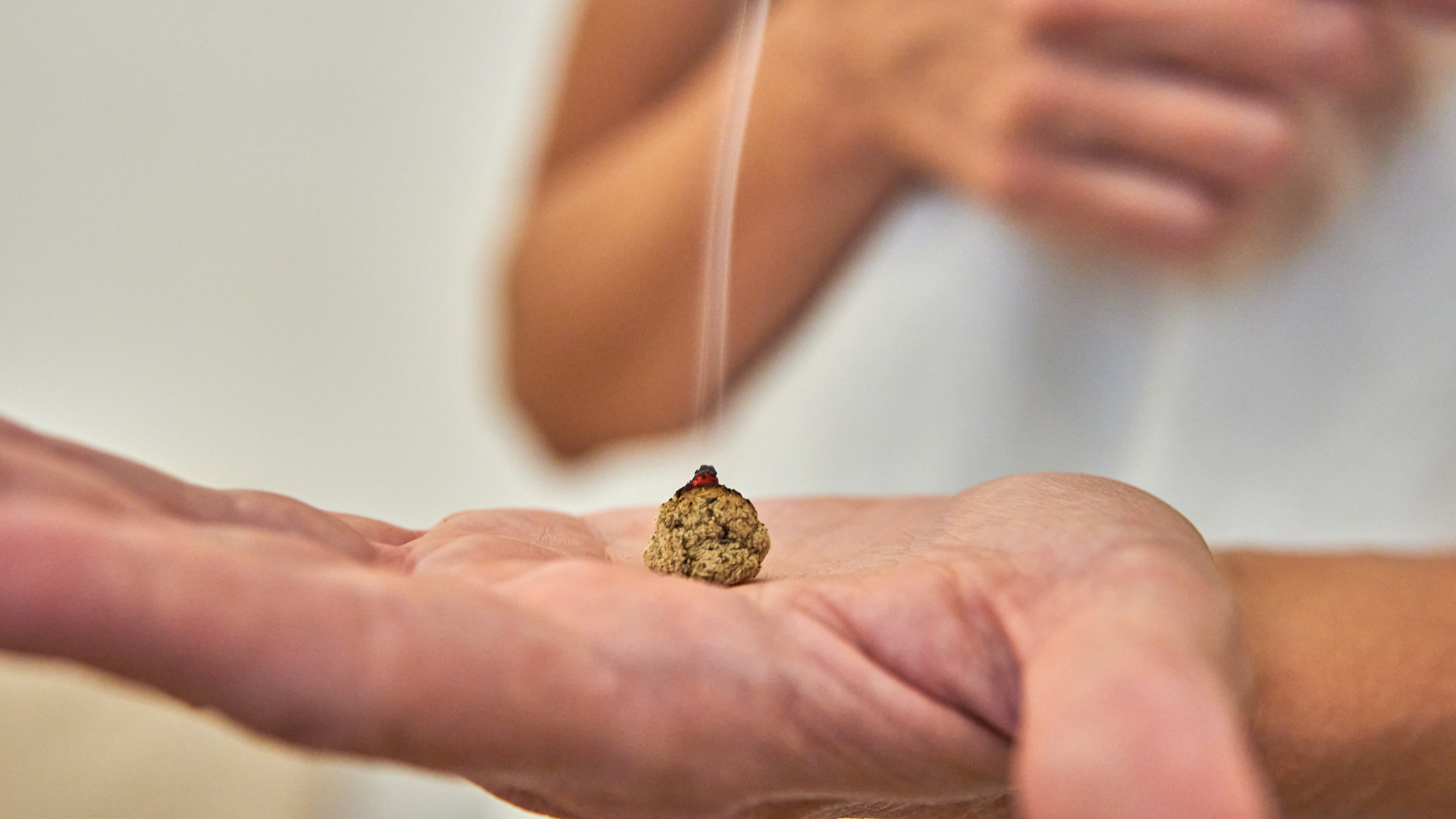
Moxibustion
Moxibustion is a heat therapy used in TCM that involves the burning of mugwort (Artemisia vulgaris) - a medicinal herb - near or on specific acupuncture points. It's a deeply rooted therapeutic practice believed to stimulate the flow of qi, dispel cold and dampness, and strengthen the body's yang energy.
What is Moxibustion?
In the framework of TCM, moxibustion serves several key therapeutic purposes:
Warms the body and pushes out cold: many health problems like pain, stomach issues, or period problems are believed to come from cold or dampness blocking the body’s energy flow. Moxibustion adds warmth, helping energy and blood move better.
Boosts energy for people who feel cold or tired: if you often have cold hands and feet, feel worn out, or have low sex drive, moxibustion can help by strengthening your body’s warming energy.
Improves circulation and eases pain: it helps blood flow more smoothly, which can reduce swelling, relieve pain, and help the body heal.
Strengthens immunity and helps prevent illness: when done regularly—especially on certain points—it’s believed to boost your body’s defences, especially in colder seasons.
Aids digestion and reproductive health: it’s often used for issues like diarrhoea, poor appetite, menstrual cramps, irregular periods, infertility, and even to help turn breech babies during pregnancy.
What does Moxibustion do?
Moxibustion involves burning dried mugwort in one of several forms:
Moxa Cone: is placed on the skin usually on a bed of salt, slice of ginger or a liniment and removed before it burns the skin - creates warmth without injury (as seen in the picture above).
Moxa Stick: A cigar-shaped stick of mugwort is lit and held a few centimetres above an acupuncture point, warming the area without contact.
Moxa on Needle: A small amount of burning moxa is placed on the handle of an inserted acupuncture needle, which conducts heat into deeper tissues.
Moxa Box: A container holds burning moxa and is placed on or near the body to heat a larger area.
In modern clinics, charcoal-based moxa may be used to avoid smoke and odour, especially in enclosed spaces.
How it works?
Sensations: usually you get a pleasant, deep warmth that penetrates the skin and muscles. Some clients feel the qi moving or notice relief in pain or tension almost immediately. There should not be burning or discomfort.
Duration: each point is typically treated for 5–15 minutes, but a full session may last up to 45 minutes, sometimes combined with acupuncture.
Smell: moxa has a distinct herbal, smoky scent - some find it calming, others may be sensitive to it. Good ventilation is used in clinics, and smokeless options are available.
Aftercare: it is important to stay warm after the session, avoid wind and cold exposure. Drink warm water to aid circulation and detoxification. You may feel relaxed, energised, or sleepy.
What to expect during the treatment?
Sources
Bae H-R, Kim E-J, Ahn Y-C, Cho J-H, Son C-G, Lee N-H. Efficacy of Moxibustion for Cancer-Related Fatigue in Patients with Breast Cancer: A Systematic Review and Meta-Analysis. Integrative Cancer Therapies. 2024;23. https://doi.org/10.1177/15347354241233226
Chen, H., He, M., Cao, J., Zhang, Y., Zhou, Y., Yu, Q., Wang, A., Xuan, J., & Li, T. (2024). Acupuncture and moxibustion intervention in functional dyspepsia: Gastric and duodenal regulation. Heliyon, 10(17). https://doi.org/10.1016/j.heliyon.2024.e35696
Dai, Y.Q., Weng, H., Wang, Q., Guo, X.J., Wu, Q., Zhou, L., & Huang, L. (2022). Moxibustion for diarrhea-predominant irritable bowel syndrome: A systematic review and meta-analysis of randomized controlled trials. Complementary Therapies in Clinical Practice, 46. https://doi.org/10.1155/2016/5105108
Deng, G., Feng, X., Zhang, H., Li, L., Cao, Q., Fu, Y., & Zhou, X. (2024). Efficacy and safety of moxibustion as a complementary and alternative therapy for asthma: A systematic review and meta-analysis. International Immunopharmacology, 139. https://doi.org/10.1016/j.intimp.2024.112760
Fang, Y.; Yue, B.W., Han-Bo MDa; Yuan, Yi-Peng MDa. (2022). Acupuncture and moxibustion for chronic fatigue syndrome: A systematic review and network meta-analysis. Medicine 101(31). https://doi.org/10.1097/MD.0000000000029310
Kung, Y.Y., Chen, F.P., & Hwang, S.J. (2006). The Different Immunomodulation of Indirect Moxibustion on Normal Subjects and Patients with Systemic Lupus Erythematosus. American Journal of Chinese Medicine, 34(1), 47-56. https://doi.org/10.1142/s0192415x0600362x
Lee, H.-S., Park, Y.-D., Lee, H.-J., Hwang, D.-S., Jang, J.-B., Lee, C.-H., … Kim, D.-I. (2022). The Effectiveness of Moxibustion Treatment in Infertility with IVF-ET: A Systematic Review and Meta-Analysis. The Journal of Korean Obstetrics and Gynecology, 35(2), 28–41. https://doi.org/10.15204/JKOBGY.2022.35.2.028
Liao, J.-A., Shao, S.-C., Chang, C.-T., Chai, P. Y.-C., Owang, K.-L., Huang, T.-H., Yang, C.-H., Lee, T.-J., & Chen, Y.-C. (2021). Correction of Breech Presentation with Moxibustion and Acupuncture: A Systematic Review and Meta-Analysis. Healthcare, 9(6), 619. https://doi.org/10.3390/healthcare9060619
Song, S.W., & Chen, H. (2025). Systematic review and meta-analysis of the effectiveness of moxibustion therapy for primary dysmenorrhea. Frontiers in Medicine, 12. https://doi.org/10.3389/fmed.2025.1545146
Tang, B., Zhang, J., Yang, Z., Lu, Y., Xu, Q., Chen, X., & Lin, J. (2016). Moxibustion for Diarrhea-Predominant Irritable Bowel Syndrome: A Systematic Review and Meta-Analysis of Randomized Controlled Trials. Evidence-Based Complementary and Alternative Medicine. https://doi.org/10.1155/2016/5105108
Xiaorong Chang. (2012). Illustrated Chinese Moxibustion Techniques and Methods. Singing Dragon
Yang, Y., Rao, K., Zhan, K., Shen, M., Zheng, H., Qin, S., Wu, H., Bian, Z., & Huang, S. (2022). Clinical evidence of acupuncture and moxibustion for irritable bowel syndrome: A systematic review and meta-analysis of randomized controlled trials. Frontiers in Public Health, 10. https://doi.org/10.3389/fpubh.2022.1022145
Ye, T.J., & Cheng, H.X.. Therapeutic efficacy of moxibustion plus medicine in the treatment of infertility due to polycystic ovary syndrome and its effect on serum immune inflammatory factors. Journal of Acupuncture and Tuina Science, 18, 269–275 (2020). https://doi.org/10.1007/s11726-020-1187-7
Zhu, RX., Li, X., Yan, ZB. et al. Efficacy and safety of acupuncture with moxibustion for knee osteoarthritis: a meta-analysis of randomized controlled trials. Syst Rev 14, 15 (2025). https://doi.org/10.1186/s13643-025-02762-x




